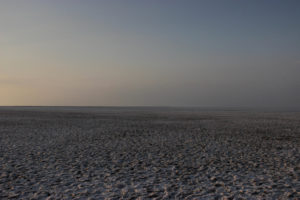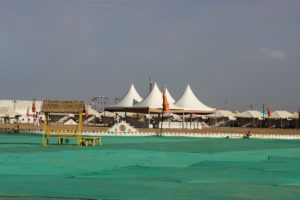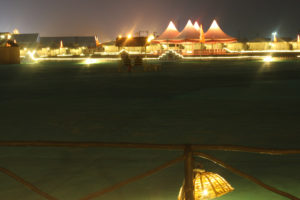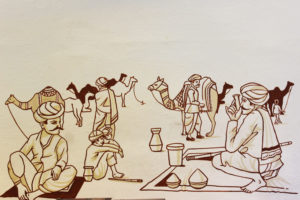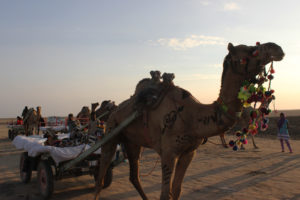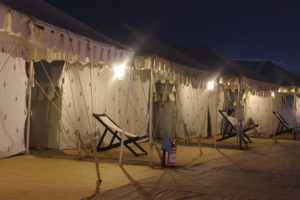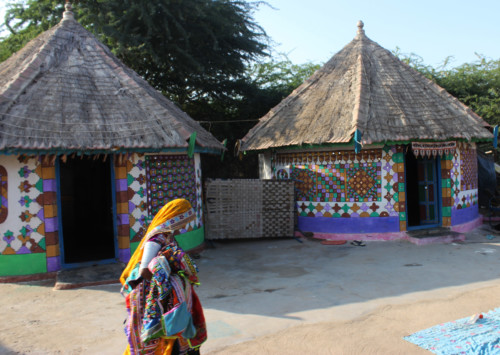Planning of a desert festival: behind the scenes of Rann Utsav
India’s largest district, a rarely traversed arid desert, comes to life in form of a culturally rich and exquisitely crafted extravaganza during the winter months. But, what goes into the making of this rare desert festival and what are the challenges faced? Here’s a sneak peek.
The Rann Utsav, literally, desert fest, celebrates the life, culture, cuisine and festivities of Kutch, the largest district in India in Gujarat, the westernmost state of India. It also marks the occurrence of the great Rann or desert here, parts of which are snowy-white and brings the barren land and the rare white desert to life.
The surrounding landscape is surreal, a shallow wetland which submerges in water during the rains and goes dry during other seasons. What surfaces is unique in characteristics and mystical in experience. The expanse of this white desert is actually a salt marsh located on the edge of the Thar Desert. A land, about 30,000 square km in area and extending to the neighbouring Sindh province in Pakistan, the Great Rann of Kutch is one of the largest white deserts in the world.
It is this uniqueness of the land that gathers thousands of tourists to this corner of India which otherwise is barely traversed and with the desert festival, it is just at the right time.
The nature readies the desert for humans to halt on its lands only after the rains and, the winter months of November to February are the best time to visit. It is during these months, the Rann Utsav is celebrated.
The Rann Utsav began in 2008 as a three-day event and has since grown manifolds. Now, a festival spanning across four months, it has passed through the phases of being a 10-day, a month long and a two moth long jamboree. With time, it has not just grown in its span of days but also its scale, magnificence and glory.
An entire tent city is set up on the barren Thar with not just the basics but also luxury put in place for the guests. These experiences are nailed in the form of tents that fill up the clusters A-K at this temporary city built in the Dhordo village of the district.
“From about 30-40 tents to 350, the increase in operational scale is evident,” says Shokat Ali, operational head at the festival. “We can accommodate around 900-950 people on a daily basis,” he says.
Ali, who has been associated with Rann Utsav since its inception, has seen it grow into a successful fest despite all the odds that the desert might pose. “The preparations begin about one-and-a-half month in advance. We come here in September and inspect the ground and check if it is viable for setting up the tents. We start by getting rid of the thorns, plants etc. that grow here and then by levelling the grounds. We call out for rollers and agencies to help us start the procedure. The first one to come is the levelling team who ready the ground before anything else can be started,” Ali explains.
Putting together an entire city of tents, with adequate facilities not just for a comfortable stay but also luxury, demands a huge work-force and management team. “We work with various agencies besides our team which help us put various pieces together. There are people looking into the structuring of tents, plumbing, electricity, designing, dining, waste management and so much more,” Ali says. “Everything is done step-by-step. After the basics are in place, factors like decoration, furniture, aesthetics, good lighting, music, shopping spheres and cultural events are taken care of,” he explains.
Reflecting Kutch’s culture
Standing true to its motive of being a celebration of the culture, cuisine and festivities of Kutch, the Rann Utsav is a fete bringing together the art, craft, the food and the traditions of this far flung district of India. There are stalls where the visitors can savour some local preparations, haats, where they can buy traditional Kutchi handicraft and joints where they can enjoy some music from Kutch and the adjoining Sindh.
“We have invited various local artisans to come and stage their products in the haat here. We are not charging them for the stalls as it is Rann Utsav’s aim to promote the local culture. While many artists and folk-performers are from Dhordo, the nearby village, many are from surrounding districts too. Thus, the ones who cannot return to their home every evening have been provided with free accommodations as well,” Ali tells us.
The Rann Utsav is a great place to experience the culture of Kutch. It’s an artist’s paradise. Village scenes have been replicated here with dummy Bhungas or traditional Kutchi huts decorating some corners, Lippan work or Kutch’s mud-and-mirror artwork adorning the walls around, traditional food items at the dining hall and of course the great Rann of Kutch which is just a hop-on and hop-off service away from the tent city.
A bus drives you to the browns of the Thar, where await camels to take you to the white desert. Commuting is not at all a hassle in this large tent city of Dhordo. There are golf carts inside and camel carts outside. Little things have been taken care of.
“Catering to the increasing footfall of tourists, we increased the number of golf carts running in the campus and also introduced eight-seat carts. The frequency of the bus service from our entrance gate up till the desert brink and back again has also been increased,” says Karan Vyas, front office manager at Rann Utsav.
Talking of the entrance gate, he enthusiastically shares some facts with us. “The entrance gate is a replica of the of Vijay Vilas palace in Mandavi,” he says. The palace is a tourist attraction near the Rann of Kutch along with a beach at Mandavi.
“In fact, it is one of the few things that remain here even after we dismantle the tent city,” he elaborates. The others include a replica of the demolished clock tower from Bhuj, the reception’s structure and the wooden floorings inside the tents.
Bringing it down, building it up
Dismantling the city is another challenge that the team faces. What was once built from scratch is pulled down layer by layer. “It takes another month to bring it down,” says Ali. “At the time of dismantling, while some things demand less attention, we have to be careful with things which we can reuse next year,” he explains.
The management at Rann Utsav builds a city of comfort and luxury in the middle of a desert and brings it down every year. The intricacies which are taken care of include details like tilling the washroom floors on the basis of “feedback forms from last year using only eco-friendly bags for exchanges, having an in-house emergency medical team and live music at the dining hall so that guests do not miss out on the fun while having dinner”.
“He builds it up, brings it down and then starts planning for next year’s event,” proudly says Vyas referring to his colleague Ali.
Technically an event, Rann Utsav is home to the ones who stay here for months and pull it together. “Everyone here works in co-ordination with each other pushing aside the challenges that the desert might pose. It is fun and for now it is home,” says Vyas.


